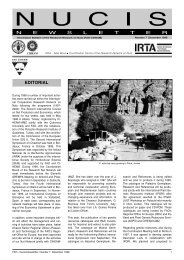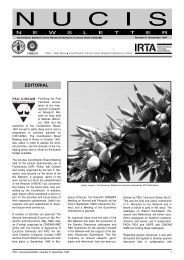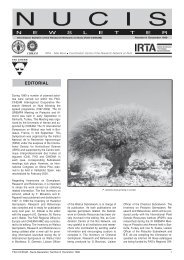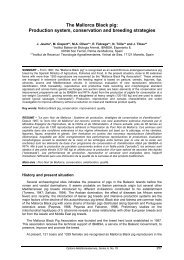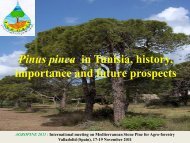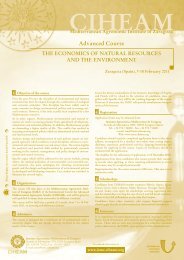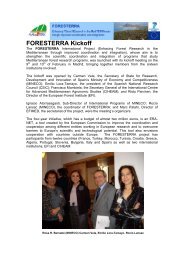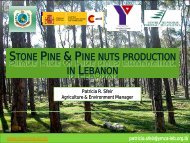NUCIS number 12. September 2004. 52 pages (full ... - IAMZ - ciheam
NUCIS number 12. September 2004. 52 pages (full ... - IAMZ - ciheam
NUCIS number 12. September 2004. 52 pages (full ... - IAMZ - ciheam
- No tags were found...
Create successful ePaper yourself
Turn your PDF publications into a flip-book with our unique Google optimized e-Paper software.
should be linked to the trait being analysed.Mapping on a segregating populationmay confirm the markers found. Thistechnique, identified as “bulk segregantanalysis” (BSA), is now commonly usedto map simple traits with RAPD markers.A variation of this technique, known as“bulked DNA analysis”, uses also twosamples of DNA mixtures, one of individualsthat express the trait, and anotherof individuals that do not express it, butwithout using a segregating population.Once a marker is identified as being relatedto a trait of interest, the developmentof SCAR or CAPS markers results in ahigher specificity and reproducibility ofthe fragments obtained. RAPD analysisfollowed by SCAR or CAPS developmenthas been used to identify markers associatedto traits of interest in plants, suchas downy mildew resistance in lettuce(Paran & Michelmore, 1993), the locusthat controls flower doubleness in carnation(Scovel et al., 1998), a new resistancegene to leaf stripe in barley (Tacconiet al., 2001), leptine content in Solanumphureja (Bouarte-Medina et al., 2002),sex determination in kiwifruit plants (Gillet al., 1998), genotypes of vine rootstocks(Xu et al., 1995), colour of fruit epidermisin apple (Cheng et al., 1996), Ma1 rootknotnematode resistance gene in Myrobalanplum (Lecouls et al., 1999) and resistanceto root-knot nematodes in peach(Lu et al., 1999).In our study, the RAPD technique wascombined with bulked DNA analysis toselect markers associated to either toleranceor sensitivity to Fusicoccum in almond.Fourteen almond cultivars classifiedas tolerant (7) or sensitive (7) to Fusicoccumwere screened with 120 RAPDprimers. Polymorphic bands were assessedfor co-segregation with tolerant orsusceptible phenotypes using 30 seedlingsobtained from a cross of ‘Masbovera’(T) x ‘Lauranne’ (S). Three RAPDmarkers were identified, two linked to tolerance(OPD-19 300and OPA-08 900) andone linked to sensitivity (OPD-19 500) toFusicoccum (Martins et al., 2001; Martinset al., 2003). SCAR primers were developedand segregation of SCAR markerswas tested, however, polymorphism betweenthe two groups (tolerant versus susceptible)was lost in this process. The developmentof CAPS markers as a possibleway to recover the lost polymorphismwill be analysed.Cosegregation analysis using the adequatepopulations is essential to confirmthe genetic base of the markers linked toa certain trait. In the case of almond, anew segregating population of some 120seedlings derived from a cross ‘Primorskyi’(T) x ‘Lauranne’ (S), is currently beingevaluated in the field, at IRTA, CentreMas Bové (Tarragona, Spain), for toleranceor sensibility to Fusicoccum. This materialwill allow the confirmation of whichfragments correspond to markers associatedto the disease. In this case it wouldbe of high interest to evaluate the possibilityof inserting these markers in the referenceEuropean Prunus genetic map, almond‘Texas’ x peach ‘Earlygold’ (TxE)(Joobeur et al., 1998).The genetic nature of tolerance to Fusicoccumin almond (or related species likepeach) is not yet defined, and further studiesare necessary to determine the modelthat can be applied to almond. Althoughartificial inoculation with Fusicoccumis currently being tested in almond(Cabrita et al., 2003), any procedure hasbeen established, so far, to efficientlyevaluate tolerance or sensibility of almondplants to Fusicoccum canker. Therefore,the identification of molecular markerslinked to tolerance or sensibility toFusicoccum, is of particular importancesince, to our knowledge, this is the onlymethod that will allow the early selectionof tolerant plants from breeding programmes,as well as the certification of tolerantcultivars to be implemented in neworchards. Symptoms development of thedisease in plants grown in the field derivedfrom breeding programmes takenabout 4 to 5 years under natural conditionsof high atmospheric humidity as it happensin the Mediterranean coast (I. Batlle,personal communication). Finally, it isimportant to highlight that the balanceand coordination among the use of moleculartechnologies and the fieldbasedwork, are essential for the success ofbreeding programmes (Scorza, 1996).REFERENCESArús P, Joobeur T, Jaúregui B, BallesterJ, Viruel MA, de Vicente MC, 1999. Marcadoresmoleculares en especies frutales:Prunus. In: Marcide JMO (ed) IdentificaciónMolecular de Germoplasmade Vid. Fundación Premio ARCE, InstitutoMadrileño de Investigación AgrariaY Alimentaria (IMIA), Madrid pp 153-165.Barbé L (1993) Favoriser le renouveaude la culture de l’amandier. Arboriculturefruitière. 358: 21-31.Bouarte-Medina T, Fogelman E, ChaniE, Miller AR, Levin I, Levy D, VeilleuxRE, 2002. Identification of molecularmarkers associated with leptine in reciprocalbackcross families of diploid potato.Theor Appl Genet 105: 1010-1018.Cabrita L, Branco V, Neves MA, Leitão J,2003. Barrinho Grado a new source of resistanceto Phomopsis amygdali in almond.XIII G.R.E.M.P.A. Meeting on Pistachioand Almond, Mirandela p 73 (Abstract).Cheng FS, Weeden NF, Brown SK,1996. Identification of codominantRAPD markers linked to fruit skin colorin apple. Theor Appl Genet 93: 222-227.Darvasi A and Soller M, 1994. Optimumspacing of genetic markers for determininglinkage between marker loci andquantitative trait loci. Theor Appl Genet89: 351-357.De Boer B, 1997. Fusicoccum - a key tomultiple 14-3-3 locks? Trends in PlantScience 2: 60-66.Gill GP, Harvey CF, Gardner RC, FraserLG, 1998. Development of sexlinkedPCR markers for gender identificationin Actinidia. Theor Appl Genet97: 439-445.Grasselly C & Crossa-Raynaud P, 1980.L’amandier. Maisonneuve et Larose,Paris.Grasselly C & Duval H, 1997. L’Amandier.Centre Technique Interprofessionneldes Fruits et Légumes, Paris.Jarvis P, Lister C, Szabo V, Dean C,1994. Integration of CAPS markers intothe RFLP map, generated using recombinantinbred lines of Arabidopsis thaliana.Plant Mol Biol 24: 685-687.Joobeur T, Viruel MA, de Vicente MC,Jáuregui B, Ballester J, Dettori MT, VerdeI, Truco MJ, Messeguer R, Batlle I,Quarta R, Dirlewanger E, Arús P, 1998.Construction of a saturated linkage mapin Prunus using an almond x peach F 2progeny. Theor Appl Genet 97: 1034-1041.Kelly JD, 1995. Use of random amplifiedpolymorphic DNA markers in breedingfrom major gene resistance to plantpathogens. HortScience 30: 461-465.Konieczny A & Ausubel FM, 1993. Aprocedure for mapping Arabidopsis mutationsusing codominant ecotype-specificPCR-based markers. Plant J 4:403-410.Lecouls AC, Rubio-Cabetas MJ, MinotJC, Voisin R, Bonnet A, Salesses G,Dirlewanger E, Esmenjaud D, 1999.RAPD and SCAR markers linked to theMa1 root-knot nematode resistancegene in Myrobalan plum (Prunus cerasiferaEhr.). Theor Appl Genet 99:328-335.Lu Z-X, Sossey-Alaoui K, Reighard GL,Baird WV, Abbott AG, 1999. Developmentand characterization of a codominantmarker linked to root-knot nematoderesistance, and its application topeach rootstock breeding. Theor ApplGenet 99: 115-122.Martins M, Sarmento D, Batlle I, VargasF, Oliveira MM, 2003. Development ofSCAR/CAPS markers linked to tolerance/sensitivityto Fusicoccum in almond.Options Méditerranéennes CIHEAM/<strong>IAMZ</strong> (in press).Martins M, Sarmento D, Batlle I, VargasF, Oliveira MM, 2001. Search for molecularmarkers linked to Fusicoccum to-14 FAO-CIHEAM - Nucis-Newsletter, Number 12 <strong>September</strong> 2004



